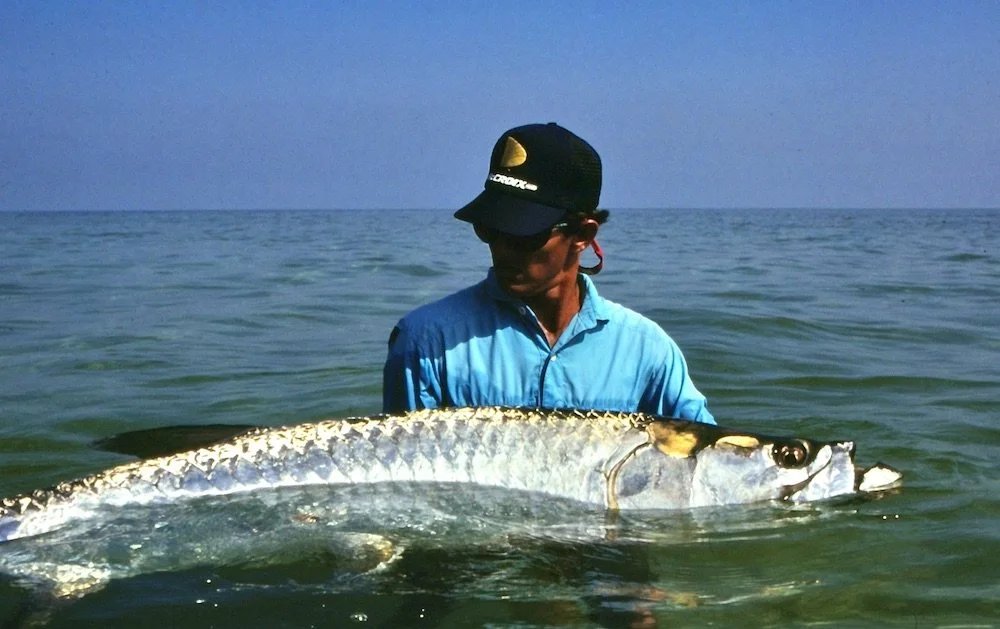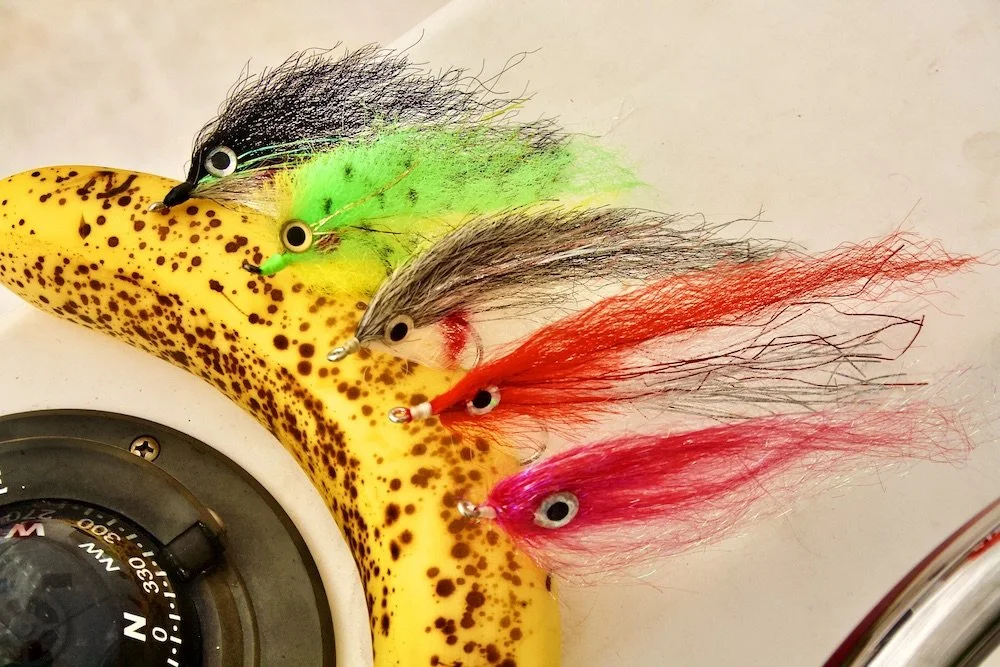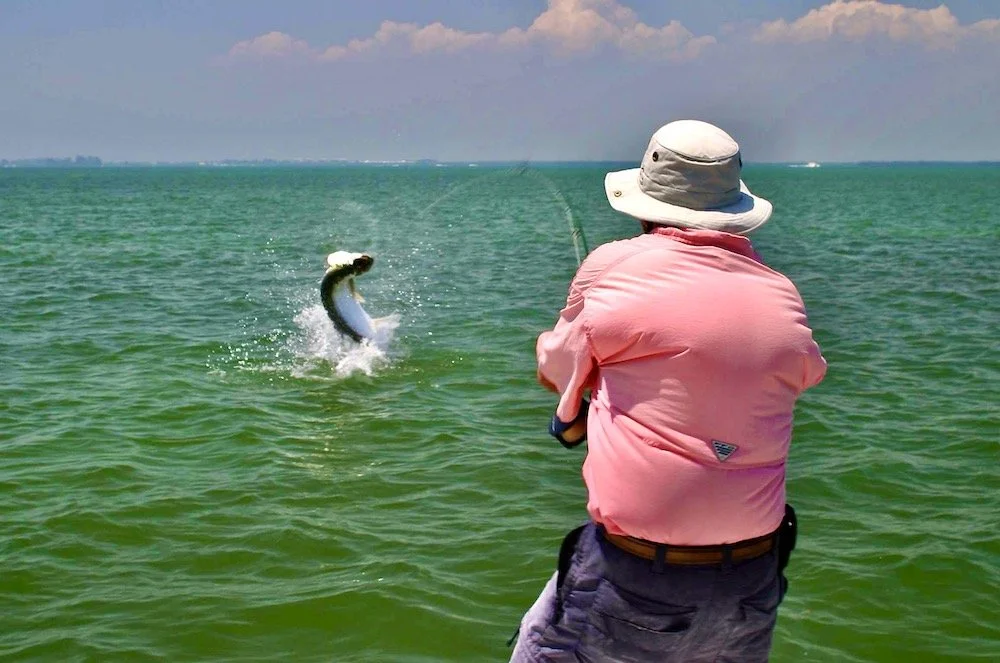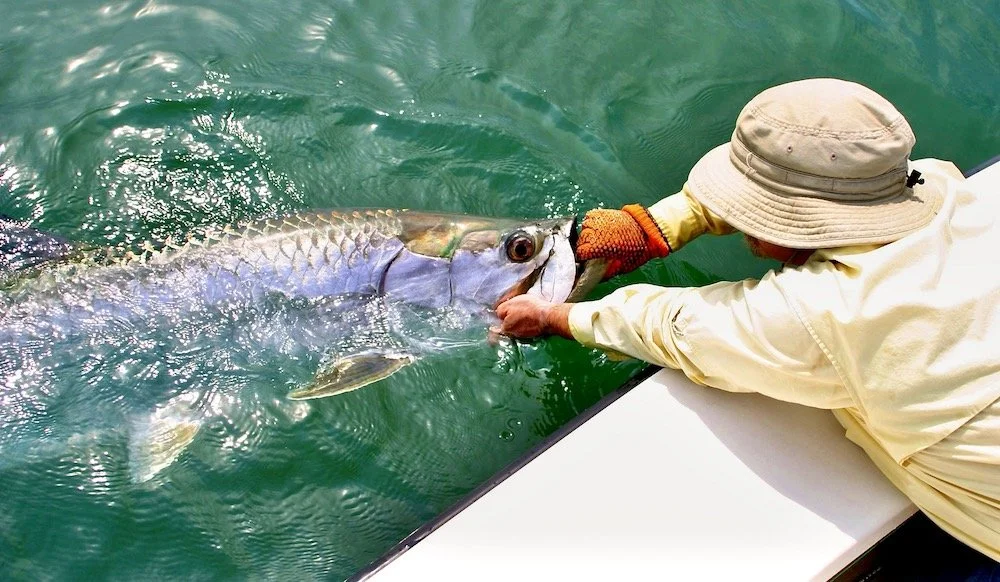Striking Silver in the Sound
By: John Kumiski
Of all the things you can do with a fly rod, few match the excitement of casting to and hooking a large tarpon in shallow water. Fighting one is another matter, and bringing one to hand is a significantly more difficult proposition. But the entire exercise possesses an extremely high entertainment value as long as the fish are there.
You can sight fish for tarpon all along the Florida peninsula. One of the best places is the Charlotte Harbor/Pine Island Sound area, along the Lee County coast, near Fort Myers on Florida’s west coast. You’ll find lots of shallow water, plenty of fish, and while solitude will likely be hard to find, there’s enough space that you won’t get run over (Memorial Day weekend excepted).
Tarpon can generally be caught from April through October (earlier and later in some places), but the best time to target them here occurs in May and June. The fish move though the sound and harbor, through the passes, and along the beaches then in large numbers, searching for food, preparing to spawn.
A young fly rodder battles a tarpon near the beach.
Tarpon fishing ain’t for sissies. These are adult fish, and although you’ll sometimes hook little 40-pound dinks the average fish weighs about 100 pounds. Sticking a 200 pounder isn’t likely but it is a distinct possibility. Don’t go into this lightly. When you have 100 pounds plus of angry tarpon at the end of your line, you can expect to get quite a workout.
If you’re good, you can whip an “average” fish in 30 or 40 minutes. If you get a hot fish, or if your technique is poor, you’ll be there for what seems like an eternity. Like people, each tarpon is different and unique. Every fish has a different attitude after getting hooked. Fighting them is not a matter of brute strength, either. You’re trying to confuse the beast into submission as much as kick its scaly butt.
There’s no shore fishing here. You need a boat. Unless you have the requisite tackle and expertise, you’ll need a guide too, at least for the first few trips. Fortunately, there are many excellent guides, both for those who prefer to fly cast and for light tackle conventional anglers.
Ten- to twelve-weight fly tackle is appropriate. While floating lines sometimes work, an intermediate or sink-tip line is generally preferred. Tippets should test at 20 pounds, and a bite tippet of 50- or 60-pound fluorocarbon gets attached to the 2/0 or 3/0 (usually) hook the fly has been tied on. A variety of flies work, including the classic Keys-style streamers, saltwater standards such as Seaducers and Deceivers, baitfish imitations such as the EP style streamers, tarpon toads, and when the crabs flush out of the passes on the hill tides, crab patterns. While you need a variety of colors, black and purple and black and gold always produce well. The smart angler carries some chartreuse flies, too.
A small sample of tarpon streamers.
On a typical “dawn patrol” trip, you will leave the dock at dark-thirty, heading for the fishing grounds. If your guide times things right (and he will), it will just be getting light when you get there. Hopefully the weather will be almost perfect, and tarpon will be rolling.
Cast in the vicinity of the rolling fish. The fish will exhibit various patterns in their rolling. They might be scattered singles. They might be moving from one place to another in clumps of various sizes, from small groups of six or eight fish to schools with dozens. They might be in a “daisy chain,” a school of fish swimming nose to tail in a circle. Daisy chains offer the finest opportunity for a hookup.
Sight fishing early in the day requires the fish to be exposing body parts to the atmosphere. As the sun climbs higher into the sky visibility improves. You can see the fish down in the water. And while they don’t usually bite as well when the sun hangs high, the visual aspect makes it much more thrilling. There’s nothing like watching your fly disappear into that five-gallon bucket of a mouth!
One day I had an angler who we’ll call Joe anchored off the beach at an intercept point. The idea was to ambush the fish as they moved along the beach. The weather and visibility were excellent, and we watched a pair of fish approach. I instructed Joe to make a cast. Joe dutifully cast the fly out in the right area. I said, “OK, move it.” What I wanted him to do was strip the fly, but what he thought I meant was, “Cast it someplace else.” Just as the larger of the two fish was moving to take the fly he pulled it out of the water.
My cry of anguish must have been heard in Miami.
Joe immediately cast the fly back into the water. It landed on the tails of the fish. To our amazement, the larger fish whipped around 180 degrees and slammed that fly, then headed straight out into the Gulf. In a disturbing development, it never jumped.
After you hook the fish, you’ll want your tarpon to jump. When it comes to jumps, more are definitely better. Jumping takes a lot of energy, so a jumping fish tires quickly. On the other hand, a fish that doesn’t jump will have a lot of stamina. Particularly when it’s a big fish, and Joe’s was, it may have more stamina than you do.
An angry hooked tarpon jumps.
I gave chase with the boat, coaching Joe as we went. In Joe’s defense, the fish was about 130 pounds, and it never jumped. He had it almost within grabbing distance several times. Honestly, in the 90-plus-degree heat, under a blazing June sun, that fish kicked Joe’s butt. Somewhere around 70 minutes into the fight the fish broke off. We were over four miles out in the Gulf. Joe sat down, spent, dazed, soaked with sweat. “You did good,” I said, a big smile on my face. Then I turned the boat, ran back to the beach, and we started looking for fish again.
Any day you hook a fish is a good day, particularly if you’re fly fishing. Expect some fishless days. Tarpon live a long time, twenty or thirty years. They have seen every bait and lure known to man. They are hounded constantly by anglers, so getting a bite is nowhere near as easy as finding fish. Be persistent, and the bites will come.
Tarpon fishing is not for everyone. When the fish are scarce it seems like the most stupid thing you could do, dumber than golf, even. You have to be prepared to fight a fish with as much or more muscle mass than you have. I’ve had several anglers who, after catching their first tarpon, never wanted another one. They wanted to fish for snook, or mackerel, or redfish, anything but tarpon.
A caught tarpon, being prepared for release.
But the angler who’s truly bitten by the bug works through the pain, the effort, the sweat, and the very real chance an angry fish may join him in the boat. And after the fish has been revived and swims off, he says, “That was so awesome! Let’s go do it again!”
Absolutely nothing compares with tarpon fishing, and Lee County offers some of Florida’s best.
Have you had a great out experience? Join Global Outdoors and write a review to tell everyone about it! We’re building the home for trusted reviews of outdoor experiences, outfitters, and guides.






